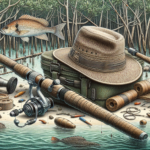Fishing Tips on How to Catch Mangrove Snapper

Introduction
The Mangrove Snapper, also known as Lutjanus griseus or the Gray Snapper, is a highly sought-after species among sport and recreational anglers. Known for its cunning behavior and strong fight, this fish provides a thrilling challenge for both novice and experienced fishermen. This article aims to provide comprehensive insights into the Mangrove Snapper, covering everything from its physical characteristics and habitat to the best fishing techniques and gear recommendations. Whether you’re a seasoned angler or a beginner, these tips will help you improve your chances of landing this elusive fish.
Fish Species Overview
Description
The Mangrove Snapper is easily recognizable by its dark brown to grayish color, often with a reddish hue. They have a streamlined body with a pointed snout and a mouth full of sharp teeth. Adult Mangrove Snappers typically range from 10 to 20 inches in length, although they can grow up to 24 inches and weigh as much as 10 pounds. Their dorsal fin is spiny, and they have a distinctive dark stripe running from their snout through their eye.
Habitat
Mangrove Snappers are versatile and can be found in a variety of environments, including freshwater, saltwater, and brackish water. They are commonly found in mangroves, estuaries, and coastal areas, often hiding among submerged structures like rocks, reefs, and shipwrecks. These fish are prevalent in the Gulf of Mexico, the Caribbean, and along the Atlantic coast of the United States, from Florida to North Carolina.
Behavior
Mangrove Snappers are opportunistic feeders, preying on a variety of smaller fish, crustaceans, and mollusks. They are most active during dawn and dusk, making these times ideal for fishing. Spawning typically occurs from June to September, during which they migrate to offshore reefs. Anglers often face challenges when targeting Mangrove Snappers due to their wariness and tendency to retreat into cover when threatened.
Best Time to Catch Mangrove Snapper
Seasonal Considerations
The best time to catch Mangrove Snapper is during the warmer months, from late spring to early fall. The peak season is usually from June to September, coinciding with their spawning period when they are more active and easier to locate.
Time of Day
Mangrove Snappers are crepuscular, meaning they are most active during the early morning and late afternoon. Fishing during these times increases your chances of success. Night fishing can also be productive, especially around well-lit areas like docks and piers.
Weather Conditions
Ideal weather conditions for catching Mangrove Snapper include overcast days with calm waters. These conditions make the fish less cautious and more likely to bite. Avoid fishing during extreme weather conditions like heavy rain or strong winds, as these can make fishing difficult and less productive.
Top Fishing Techniques for Mangrove Snapper
Technique 1: Bottom Fishing
Bottom fishing is one of the most effective techniques for catching Mangrove Snapper. This method involves dropping your bait to the bottom and waiting for the fish to bite. Use a weighted rig to keep your bait near the structure where Mangrove Snappers are likely hiding. Live bait such as shrimp, small fish, or crabs works best for this technique.
Technique 2: Jigging
Jigging involves using a weighted lure that is jerked up and down to mimic the movement of prey. This technique is effective for Mangrove Snapper because it triggers their predatory instincts. Use a medium to heavy rod with a fast-action tip for better control and sensitivity. Metal jigs or soft plastic lures are recommended.
Technique 3: Free-Lining
Free-lining is a less common but effective technique for targeting Mangrove Snapper. This method involves using a live bait without any weights, allowing it to swim naturally. This technique works well in shallow waters or when fishing near the surface. Use a light to medium rod and reel setup for better control and sensitivity.
Pro Tips
- Use Fluorocarbon Leaders: Mangrove Snappers have sharp teeth and can easily cut through regular fishing lines. Using a fluorocarbon leader increases your chances of landing the fish.
- Stay Stealthy: Mangrove Snappers are wary fish. Avoid making loud noises or sudden movements that could scare them away.
- Chum the Waters: Chumming can attract Mangrove Snappers to your fishing spot. Use small pieces of fish or shrimp as chum.
Recommended Gear for Catching Mangrove Snapper
Fishing Rod and Reel
A medium to heavy spinning or baitcasting rod and reel setup is ideal for Mangrove Snapper. Look for a rod that is 6 to 7 feet long with a fast-action tip for better sensitivity and control. Reels with a high gear ratio are recommended for quick retrieval.
Fishing Line
Use a braided line with a strength of 20 to 30 pounds for better sensitivity and durability. Pair it with a fluorocarbon leader of 20 to 30 pounds to prevent the fish from cutting the line with their sharp teeth.
Hooks and Baits
Circle hooks in sizes 2/0 to 4/0 are ideal for Mangrove Snapper. Live baits such as shrimp, small fish, and crabs are highly effective. Artificial lures like soft plastics, jigs, and metal spoons can also work well.
Additional Gear
- Bobbers: Useful for keeping your bait at the desired depth.
- Sinkers: Necessary for bottom fishing to keep your bait near the structure.
- Leaders: Fluorocarbon leaders are essential to prevent the fish from cutting the line.
Best Locations to Find Mangrove Snapper
General Locations
Mangrove Snappers are commonly found in coastal areas, estuaries, and mangroves. They prefer environments with plenty of cover, such as submerged structures, reefs, and shipwrecks.
Specific Regions
Popular regions for Mangrove Snapper fishing include the Gulf of Mexico, the Caribbean, and the Atlantic coast of the United States, particularly Florida, Louisiana, and Texas. Specific spots like the Florida Keys, Tampa Bay, and the Louisiana marshes are known for their abundant Mangrove Snapper populations.
Common Mistakes to Avoid
Mistake 1: Using the Wrong Bait
Using the wrong bait can significantly reduce your chances of catching Mangrove Snapper. Always use live bait like shrimp, small fish, or crabs, as these are their preferred prey.
Mistake 2: Fishing at the Wrong Time
Fishing during the wrong time of day or season can make it difficult to catch Mangrove Snapper. Always fish during dawn or dusk and during the warmer months for the best results.
Mistake 3: Ignoring the Structure
Mangrove Snappers love hiding in structures like reefs, rocks, and shipwrecks. Ignoring these areas can result in a less productive fishing trip. Always target areas with plenty of cover.
Catch and Release Tips
Importance of Conservation
Practicing catch and release is crucial for the conservation of Mangrove Snapper populations. It ensures that future generations can enjoy the thrill of catching this species.
Proper Handling Techniques
- Use Wet Hands: Always wet your hands before handling the fish to prevent removing their protective slime coat.
- Minimize Air Exposure: Keep the fish in the water as much as possible to reduce stress.
- Use Circle Hooks: Circle hooks are less likely to cause deep hooking, making it easier to release the fish unharmed.
Legal Considerations
Always check local regulations regarding size limits, bag limits, and protected areas before fishing for Mangrove Snapper. Adhering to these regulations is essential for sustainable fishing practices.
Frequently Asked Questions (FAQs)
What is the best bait for catching Mangrove Snapper?
The best bait for catching Mangrove Snapper includes live shrimp, small fish, and crabs. These baits mimic their natural prey and are highly effective. Artificial lures like soft plastics and jigs can also work well, especially when mimicking the movement of live bait.
Where is the best place to fish for Mangrove Snapper?
Mangrove Snappers are commonly found in coastal areas, estuaries, and mangroves. Popular fishing spots include the Gulf of Mexico, the Caribbean, and the Atlantic coast of the United States. Specific regions like the Florida Keys, Tampa Bay, and the Louisiana marshes are known for their abundant Mangrove Snapper populations.
What time of day is best for catching Mangrove Snapper?
The best time of day to catch Mangrove Snapper is during dawn and dusk when they are most active. Night fishing can also be productive, especially around well-lit areas like docks and piers.
What type of fishing line should I use for Mangrove Snapper?
Use a braided line with a strength of 20 to 30 pounds for better sensitivity and durability. Pair it with a fluorocarbon leader of 20 to 30 pounds to prevent the fish from cutting the line with their sharp teeth.
Do I need a special fishing license to catch Mangrove Snapper?
Yes, you typically need a fishing license to catch Mangrove Snapper. Check local regulations for specific requirements, including size limits, bag limits, and any special permits needed.
What is the best technique for catching Mangrove Snapper?
Bottom fishing is one of the most effective techniques for catching Mangrove Snapper. This method involves dropping your bait to the bottom and waiting for the fish to bite. Live bait such as shrimp, small fish, or crabs works best for this technique.
Are there any specific weather conditions that improve the chances of catching Mangrove Snapper?
Ideal weather conditions for catching Mangrove Snapper include overcast days with calm waters. These conditions make the fish less cautious and more likely to bite. Avoid fishing during extreme weather conditions like heavy rain or strong winds.
Can I catch Mangrove Snapper from the shore, or do I need a boat?
You can catch Mangrove Snapper from the shore, especially in areas with plenty of cover like mangroves, docks, and piers. However, having a boat allows you to access offshore reefs and other structures where Mangrove Snappers are commonly found.
How can I improve my chances of landing a big Mangrove Snapper?
To improve your chances of landing a big Mangrove Snapper, use larger live baits like small fish or crabs. Target areas with plenty of cover, such as reefs and shipwrecks, and fish during dawn or dusk when they are most active.
What should I do if I plan to release Mangrove Snapper after catching them?
If you plan to release Mangrove Snapper, practice ethical catch and release techniques. Use wet hands to handle the fish, minimize air exposure, and use circle hooks to reduce deep hooking. Always check local regulations regarding size limits and protected areas.
Conclusion
In summary, catching Mangrove Snapper requires a combination of the right techniques, gear, and timing. By understanding their behavior, habitat, and feeding habits, you can significantly improve your chances of success. Remember to practice ethical fishing and conservation techniques to ensure that future generations can enjoy the thrill of catching this remarkable species. So grab your gear, head to your favorite fishing spot, and put these tips to the test. Happy fishing!




